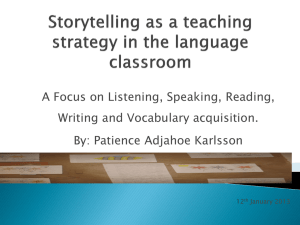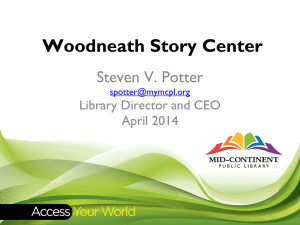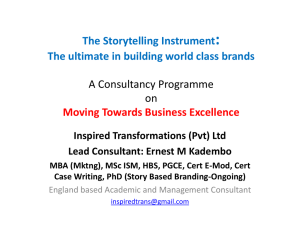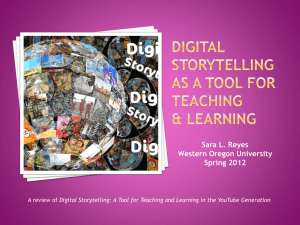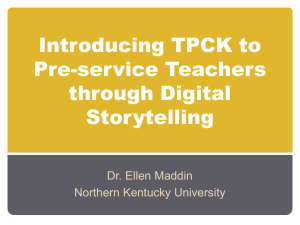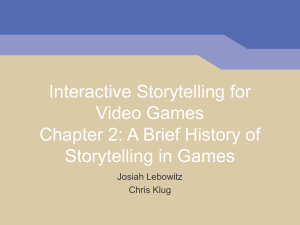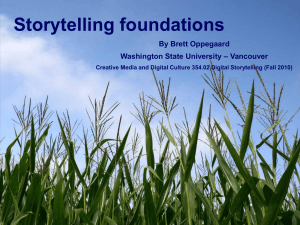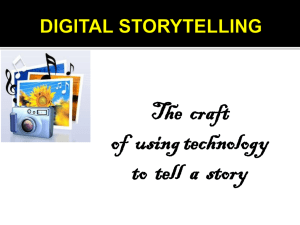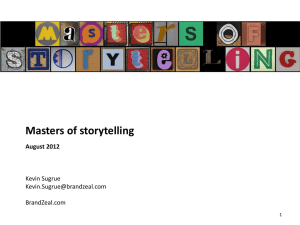Using Digital Storytelling in an ESL Classroom
advertisement
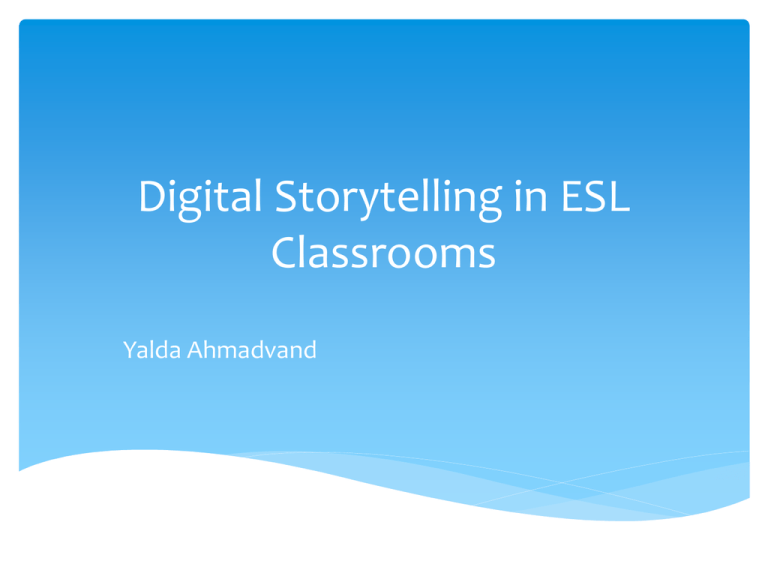
Digital Storytelling in ESL Classrooms Yalda Ahmadvand What is Digital Storytelling? Digital storytelling is a short clip which is the practice of combining narrative with digital content by using computer-based tools. It consists of: 1. Oral or/and written text 2. Images 3. Strong emotional component 4. Sound What is Digital Storytelling? Other terms use to describe digital storytelling: 1. Computer-based narratives 2. Interactive storytelling 3. Digital essay 4. Digital documentaries It is the art of telling stories using different multimedia, as well as graphics, music, audio, video clips, and Web publishing. What is Digital Storytelling? It can be efficiently applied to almost any subject. The topics: Personal tales Historical events Exploring life from one’s own community or any other places in the world What is Digital Storytelling? For creating influential narrative, the storyteller requires to consider the audience’s perspective and think about the topic carefully. Why is it significant? Stories are the foundation of every culture, and people often tell stories to teach beliefs and values to others Traditional storytelling was used as a way of knowledge transfer and a source, and a basis of education. Technology Why is it significant? The storyteller chooses a topic that can be properly conveyed to a particular audience. Chooses the images, sound and words, with electronic elements, and in a limited time. Digital storytelling let the students to express themselves with their own words, and with their own voice. Why is it significant? The strong point of Digital Storytelling: users with no or little technological background can create a digital storytelling easily. Why is it significant? According to Barret (2005), “digital storytelling facilitates the convergence of four student-centered learning strategies: student engagement reflection for deep learning project-based learning and the effective integration of technology into instruction.” The Seven Elements of Effective Digital stories Digital storytelling originated at the Center for Digital Storytelling founded by Joe Lambert at U.C Berkeley in 1993. They believed that everyone has a story to tell, and digital technologies offer powerful means for conveying it to others. The Seven Elements of Effective Digital stories A digital storytelling covers all the elements of traditional stories like setting, plot, theme, character, conflict, and point of view. Lambert identifies seven key elements for effective digital storytelling : point of view, a dramatic question, emotional content, economy, pacing, the gift of your voice, and accompanying soundtrack. Point of view: Every story should have a point. Point of view expresses what the main point of the story and the perspective of the author are. Digital storytelling gives the power to the author to express his or her personal experiences. Students should use their own story and personal experiences. We use the first person pronoun “I” instead of third person pronoun to separate digital storytelling from the PowerPoint report which is usually used for research reports. Dramatic Question: A dramatic question is a question that grabs the audience’s attention and it will be answered by the end of the story. Picking up some pointless pictures, and accompany them with some narratives and a music will not attract the audience’s attention, and won’t make them listen to the story to the end. Invest on an evoking question to make the audiences pursue the story for the eventual payoff at the closing of the story shape their story in a way that they can surprise and reward the audience at the end. Emotional Content: The effective digital story can evoke audiences’ emotion and connect them to the story. Emotion is created in every aspect of the process, such as words, images, voice and music. Seeing audiences’ reaction to the story shows that the writer was successful in making the story and engaging the audience, and it validates his or her effort and creativity. The Gift of Your Voice: Digital storytelling helps the voice of the students to be heard.(Reluctant to participate) Digital storytelling helps the students to narrate their own story, and record themselves. One of the most effective elements in digital storytelling is using your own voice to tell your story and personalize it. The power of the soundtrack: Choosing a right music Music can enhance and embellish the story. Adding the music to the story can be done at the end of the construction process. Encourage the students to use instrumental music instead of lyrical. Mention the importance of addressing copyright when music is employed. There are some sites that offer music that can be downloaded and be used for educational purposes. Economy: Economy, which means using just enough content to sharpen the focus of the story, can be the most difficult part for the experienced and beginner writers. The suggested length for digital storytelling is three to four minutes This limitation has two practical benefits: Economy First: It can be manageable to be done during school hours, and make it possible for an audience to view all the students’ stories in a single session. Second: It makes the writer focus on what is really essential for the story to be written, and it is sharpen the focus of the story. Experts believe that the effective digital story uses only few images, less visual effect, and a few words to powerfully communicate envisioned meaning. Pacing Pacing or rhythm of the story is an important factor for holding the audience’s attention. The art of storytelling is to use varied inflection and pace, which means pulling back or racing forward when it is required. This makes an important interaction between economy and pacing If the story is too long, the storyteller often wants to tell the story quickly, and it obliges them to pause or vary the pace. The best approach is to retain the focus of the story when the story is constructed, and use natural pace and voice punctuation Educational Use of Digital storytelling Digital storytelling allows students become creative storytellers by using technology It is well-positioned to help teachers to overcome some obstacles to productivity using technology in their classrooms. It can be an effective instructional tool for teachers, and an effective learning tool for students. Educational Use of Digital storytelling Teachers: can create their own stories to engage students into the lesson, and capture their attention in exploring new ideas. Create a story to facilitate discussions and making abstract or conceptual content more understandable. Research has shown that using multi media in teaching helps students retain information for longer period of time, and assists them in understanding of difficult materials. Educational Use of Digital storytelling students: Digital storytelling can develop creativity and critical thinking it allows students’ personal voice to be heard. It develops students’ communicative skills, and it improves independent learning. Helps students reflect upon their own learning and find a link between their classroom, and out of class experience. Develop literacy and proficiency with multimedia applications. After viewing the samples, teachers can ask students to research about a specific topic, choose their point of view and try to create their own story. This type of activities can generate interest and creativity in students. Make them go to a library or using countless online resources to gather contents for their story. Learn to organize their ideas, express opinions and construct narratives in an engaging way. Educational Use of Digital storytelling after making the stories, students can publish their stories online. It’s an opportunity to see each other's work and gain valuable experience in critiquing their own or other’s work. Digital storytelling can be used in a class with diverse learning styles. Digital Storytelling in ESL Classroom It is a tool that ESL teachers can incorporate in their teaching. ESL students can benefit from using it by reflecting in English and developing their oral skills to speak the language. From pedagogical perspective, digital storytelling improves: Reading Writing Speaking Listening Reflection Critical thinking Research skills Digital Storytelling in ESL Classroom It can also help students to improve their technology skills by providing an opportunity to interact by technology It is an exceptional tool for assessing students’ language skills, and their understanding of a specific subject informally Things to Consider Students need to have access to computers with internet connections. Students need to browse the web, find pictures or information for their project. Teachers need to ensure computers have decent working microphones for students for recording their narratives. Computers need to be well equipped with necessary software tool. There is some popular digital storytelling software such as: iMovie (import video footage and edit video clips) Windows Movie Maker (part of every Windows XP or Vista S installation) Microsoft Photo Story 3 (available for download from Windows XP) Final Cut Express (video editing software) Mac Audacity (digital audio editor and recording application) Above all, we need to ensure that students are familiar with basic computer skills such Saving files copy and paste function Students don’t need advanced computer skills. Steps of preparing the story in ESL classrooms The first step in creating a story is Script development. Students will write the story, often with a group to provide story development ideas and feedback on the story. This stage usually takes more than one session depending on your learning objectives. Ask students to submit their draft of their script first in order to check their grammatical mistakes. Steps of preparing the story in ESL classrooms The second step is collecting pictures Students download and edit images that they want to choose for their story. It helps students to use their creativity in finding original images that are meaningful reflection to their stories To make this step more meaningful, as a teacher you might have them to justify their choices. Steps of preparing the story in ESL classrooms Then students should record their voices Students need to practice their narration work on their pronunciation, intonation, and fluency. Then they should combine the narration and images, and add music tracks. Steps of preparing the story in ESL classrooms Teachers can use a computer projector, and in a special presentation session. It is better not to give them feedback on the form and structure right away or even after finishing their presentation. This project is mainly based on communicative approach and its focus is primarily on the process not the final products. Issues Time: Creating digital storytelling takes time Teachers must be prepared for the time a studentcentred digital storytelling might need. Issues Training: Although digital storytelling project needs basic computer knowledge, students often need to be trained for the skills needed for a digital storytelling project. Issues Structure: For creating a meaningful digital storytelling, we need to consider its structure. Without suitable structure, students might just put some pictures and music together without focusing on their story which must always be the focal point. Issues Emotion and trust: Students might not feel comfortable sharing their feeling and emotions with others. Teacher should create a positive and safe environment in the classroom to encourage students to talk about their feelings and emotions. Issues Access: Most of the teachers might not have access to what they need to create the digital storytelling. Do not expect that students have access to technology or other things they need to complete their project. Provide students an opportunity to produce their project Issues Assessment: Assessment of the digital storytelling project is something that teachers must carefully plan for it. Teachers can create rubrics for assessing students work. It can be quite informal.
